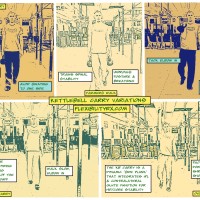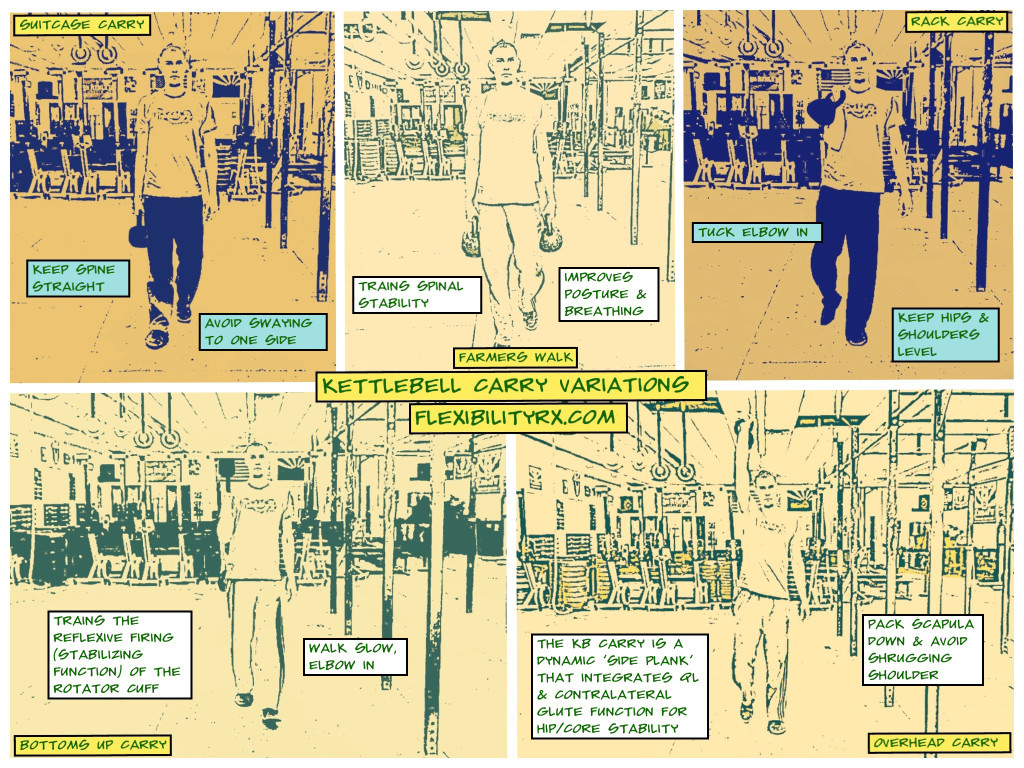
Kettlebell Carry Variations
Dan John explains,
As noted before, in terms of “popularity,” the five basic human movements from the Strength Coach’s perspective are in this order:
1. Push
2. Pull
3. Hinge
4. Squat
5. Loaded Carry
However, in terms of simple impact, the ability to be a “game changer” to an athlete, this is the order:
1. Loaded Carry
2. Squat
3. Hinge
4. Pull
5. Push
Dan John has a way of simplifying strength and conditioning concepts to the most fundamental level. I highly recommend the book, “Easy Strength” to all coaches working with athletes.
Kettlebell carries are great for improving posture, breathing, lumbo-pelvic stability, spinal stabilization, and shoulder function.
“Grab a kettlebell before your workout or on your recovery day and incorporate one of these often overlooked exercises to strengthen the hips, improve core stabilization, and shoulder stability.”
Kettlebell Carries
Suitcase Carry
The suitcase carry is a dynamic side plank that improves low-back and hip stability. The suitcase carry improves lateral stability – poor lateral stability is often a cause of knee and low-back pain. Carrying a purse over one shoulder or backpack with one strap often creates imbalances – by tilting the shoulders, spine, and hips to one side. The suitcase carry trains stability – an athlete has to resist the pull of the weight by keeping the hips ands shoulders level.
The suitcase carry is a unique exercise that trains the low-back on one side (quadratus lumborum) to work with the glute on the opposite side. Side planks train the low-back to resist movement. Half-kneeling exercises train the glutes to stabilize the hips. The suitcase carry integrates low-back and glute function requiring them to work together to stabilize the lumbar spine and pelvis.
Integrative exercises that teach dynamic movement patterns are often a missing component of physical therapy. A comprehensive rehab progression consists of isolated activation exercises, isotonic strengthening, and then movement training that re-establishes proper motor control.
The third part of the continuum (movement training) is often neglected. The lateral stability sequence (covered here), includes exercises for the low-back (side-plank), glutes (single-leg RDL), and kettlebell carry – which is an integrative exercise.
Farmers Walk
The farmers walk is an excellent core stability exercise. While the suitcase carry is great for training the low-back on the weaker side, farmers walks involve holding a weight in each hand. Once an athlete feels comfortable carrying heavier weights in each hand with the suitcase walk – equal weight on each side – they can progress to a heavy farmers walk.
This exercise requires the diaphragm to perform both it’s stabilization and breathing functions together. This is a great way to get to train the diaphragm for both functions. One rep max lifts use the diaphragm primarily for stabilization, the athlete holds their breath. Exercises like running or box jumps rely on the diaphragm primarily for breathing. The farmers walk requires the diaphragm to perform both roles at once – integrating posture and breathing.
Rack Carry
The rack carry is a nice progression from a farmers walk to the overhead carry. Integrating core stability and scapular stability – the exercise teaches athletes to maintain thoracic extension and support weight in the rack position.
Overhead Carry
Overhead carries are an excellent scapular stability exercise. The overhead arm position requires scapular upward rotation and stability to maintain that position.
Bottoms-Up Carry
The bottoms-up carry is great for shoulder health. The bottoms-up carry challenges the stabilizing function of the rotator cuff and scapular stabilizers for improved shoulder function. Training the rotator cuff as a stabilizer of the shoulder is an often-overlooked part of both physical therapy and strength training.
While the four muscles that compromise the ‘rotator cuff’ internally and externally rotatre the shoulder – their most important function is to stabilize the head of the humerus in the shoulder joint. The instability from holding the kettlebell upside down causes a ‘reflexive firing’ of the rotator cuff – to stabilize the shoulder.
“The loaded carry does more to expand athletic qualities than any other single thing I’ve attempted in my career as a coach and athlete. And I do not say that lightly.” – Dan John
– Kevin Kula, “The Flexibility Coach” – Creator of FlexibilityRx™
Related Resources
Dan John: The Secret of Loaded Carries (link)
Dan John: The Four Steps (link)
Craig Liebenson: Functional Training with the Kettlebell (link)
Chad Waterbury: QL Training w/Dr. Liebenson Part 3: Functional KB Exercise (link)
Eric Cressey: 1-arm Bottoms-up Kettlebell Waiter’s Walk (link)
The Manual Therapist: Kettlebell Carries for Scapular Dyskinesis (link)
Tags: bottoms-up kettlebell carry, dynamic side plank, farmers walk, functional kettlebell training, kettlebell carry, lateral stability exercises, loaded carries, suitcase carry, waiters walk

Leave A Reply (No comments so far)
You must be logged in to post a comment.
No comments yet